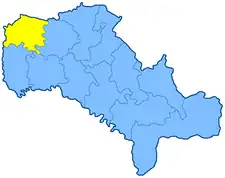Proskurov uezd
Проскуровскій уѣздъ | |
|---|---|
 Coat of arms | |
 Location in the Podolia Governorate | |
| Country | Russian Empire |
| Krai | Southwestern |
| Governorate | Podolia |
| Established | 1795 |
| Abolished | 1923 |
| Capital | Proskurov |
| Area | |
| • Total | 2,691.06 km2 (1,039.02 sq mi) |
| Population (1897) | |
| • Total | 226,091 |
| • Density | 84/km2 (220/sq mi) |
| • Urban | 10.11% |
| • Rural | 89.89% |
The Proskurov uezd[lower-alpha 1] was a county (uezd) of the Podolia Governorate of the Russian Empire, with its administrative centre in Proskurov (contemporary Khmelnytskyi). It border the Starokonstantinov uezd of the Volhynian Governorate to the north, the Letichev uezd to the east, the Kamenets-Podolsky uezd to the south, and Austria to the west. The area of the uezd covered most of Ukraine's Khmelnytskyi Raion.
Administrative divisions
The subcounties (volosts) of the Proskurov uezd in 1912 were as follows:[1]
| Name | Name in Russian | Capital |
|---|---|---|
| Kuzmino volost | Кузьминская волость | Kuzmino |
| Malinichi volost | Малиническая волость | Malinichi |
| Pashkovtsy volost | Пашковецкая волость | Pashkovtsy |
| Sarnovo volost | Сарновская волость | Sarnovo |
| Trerelniki volost | Третельникская волость | Tretelniki |
| Felshtin volost | Фельштинская волость | Felshtin |
| Cherno-Ostrov volost | Черно-Островская волость | Cherno-Ostrov |
| Sharovka volost | Шаровская волость | Sharovka |
| Yurintsy volost | Юринецкая волость | Yurintsy |
| Yarmolintsy volost | Ярмолинецкая волость | Yarmolintsy |
Demographics
At the time of the Russian Empire Census on 28 January [O.S. 15 January] 1897, the Proskurov uezd had a population of 226,091, including 114,020 men and 112,071 women. The majority of the population indicated Little Russian[lower-alpha 2] to be their mother tongue, with significant Jewish and Polish speaking minorities.[4]
| Language | Native speakers | Percentage |
|---|---|---|
| Little Russian[lower-alpha 2] | 176,685 | 78.15 |
| Jewish | 27,299 | 12.07 |
| Polish | 14,512 | 6.42 |
| Great Russian[lower-alpha 2] | 6,586 | 2.91 |
| Tatar | 570 | 0.25 |
| German | 179 | 0.08 |
| Romanian | 60 | 0.03 |
| White Russian[lower-alpha 2] | 44 | 0.02 |
| Czech | 32 | 0.01 |
| Chuvash | 22 | 0.01 |
| French | 9 | 0.00 |
| Mordovian | 9 | 0.00 |
| Bashkir | 8 | 0.00 |
| Cheremis | 6 | 0.00 |
| Votyak | 5 | 0.00 |
| Latvian | 3 | 0.00 |
| Other | 62 | 0.03 |
| Total | 226,091 | 100.00 |
Notes
- ↑
- 1 2 3 4 Prior to 1918, the Imperial Russian government classified Russians as the Great Russians, Ukrainians as the Little Russians, and Belarusians as the White Russians. After the creation of the Ukrainian People's Republic in 1918, the Little Russians identified themselves as "Ukrainian".[2] Also, the Belarusian Democratic Republic which the White Russians identified themselves as "Belarusian".[3]
References
- ↑ Волостныя, станичныя, сельския, гминныя правления и управления, а также полицейские станы всей России с обозначением места их нахождения [Volostny, stanichnaya, rural, communes of government and administration, as well as police camps throughout Russia with the designation of their location]. Kiev: Izd-vo T-va L. M. Fish. 1913. p. 162. Archived from the original on 2022-12-11.
- ↑ Hamm, Michael F. (2014). Kiev: A Portrait, 1800–1917. Princeton University Press. p. 83. ISBN 978-1-4008-5151-5.
- ↑ Fortson IV, Benjamin W. (2011). Indo-European Language and Culture: An Introduction. John Wiley & Sons. p. 429. ISBN 978-1-4443-5968-8.
- 1 2 "Демоскоп Weekly - Приложение. Справочник статистических показателей". www.demoscope.ru. Retrieved 2019-12-19.